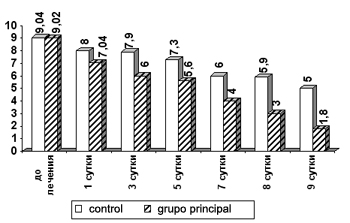COMPLEX ASSESSMENT OF EFFICIENCY OF DYNAMIC ELECTRONEUROSTIMULATION UNDER VERTEBROGENOUS CERVICAL AND LUMBAR RADICULOPATHIES
Sh. H. Arifdzhanov, H. Abdusattarova Republic Scientific Center of Emergency Medical Aid Tashkent, Uzbekistan
The purpose of the research was to assess influence of dynamic electroneurostimulation (DENS) on intensity of the pain syndrome in patients with vertebrogenous cervical and lumbar Radiculopathies. DENS efficiency was assessed in 31 patients of the main group as compared with the control group (26 people) in compliance with 10-rate visual and analog scale of pain. More pronounced and earlier pain relief was registered in patients who had DENS, good tolerance of procedures can also be noted.
Key words: vertebrogenous cervical and lumbar radiculopathy, pain syndrome, visual and analog scale of pain, dynamic electroneurostimulation.
According to some scientists, vertebrogenous cervical and lumbar radiculopathies can be found more often in working-age population [1]. They are accompanied with a long-term and quite often fixed loss of working capacity because of pronounced pain syndrome. At present, complex measures aimed at reduction and relieving of the stable pain syndrome, reduction of the duration of temporary incapacity for work as well as prevention of recurrence of the disease are taken.
Dynamic electroneurostimulation (DENS) is a method of non-drug treatment based on exposure on reflexogenic zones and acupuncture points with impulses of electric current, form of which depends on the amount of electrical resistance (impedance) of the skin surface in the subelectrode zone. The therapeutic action of DENS is based on reflex mechanisms actuated by stimulation of receptors in reflexogenic zones and acupuncture points. As a result, treatment with DiaDENS apparatus results in a chain of mechanism responses.
It is known that for successful treatment with the method of reflexotherapy it is important to be exact with three main rules: to select correct type, place and time of the procedure. The following factors influence individual appreciation of pain: gender, age, emotional and physical state of the patient. Information provided by the patient about changes in pain depending on the type of therapy is also of importance.
With lumbosacral radiculitis, the fifth lumbar root and the first sacral root are affected. The patients have pain in the lumbar region, which becomes acute during movements in the lumbar region and a corresponding extremity. During examination, a reflex tension of long muscles of the back in the zone of a corresponding spine part is revealed. Palpation of paravertebral points in the region of the lumbar spine causes acute pains. Positive symptoms of Laseg, Neri’s tension are revealed. With cervical radiculopathy, the fourth, fifth and sixth cervical roots are mainly affected. Due to pronounced pain syndrome, the head position becomes forced, pains expand also on the upper part of the arm, arm and suprascapular zone. During examination, hypoesthesia in the innervation zone of one or another root becomes apparent.
Absence of adequate criteria for assessment of sensations of pain and factual methods of measuring pain intensity is often a cause for diagnostic and medical pitfalls.
The purpose of the present research was to assess DENS influence on intensity of the pain syndrome in patients with vertebrogenous cervical and lumbar radiculopathies.
Patients and methods of research. 57 patients (25 women and 32 men) in the age from 35 to 70 years had a treatment course in the department of emergency neurology of the republic scientific center of emergency medical aid. After arriving to the hospital, all patients had typical signs of vertebrogenous cervical (17 patients) or lumbar (40 patients) radiculopathy with acute pains intensified during movement. Three fourths of the patients had a pain syndrome caused by super-cooling, one fourth of patients – by lifting heavy loads.
All patients were divided into two groups: the main group who had DENS procedures by the methods described by authors [2] in addition to standard therapy included 31 patient; the control group which had only standard therapy included 26 patients.
DENS was carried out with DiaDENS-DT apparatus. Zones of local painfulness were treated at frequencies 10, 77 and 140 Hz. Energy level of treatment was selected individually. Starting time of the exposure was 5 minutes with gradual daily increase of the procedure duration up to 20 minutes. Total therapy course consisted of 6-10 procedures.
To make therapy results more objective, all patients of the main and control groups were asked to assess intensity of the pain syndrome daily by visual and analog scale of pain (VAS) by 10-point system.
At the same time, examination of DENS influence on indexes of blood pressure and heart rate before and after the procedure was carried out.
In the hospital, patients had glucocorticosteroids, non-steroid anti-inflammatory preparations, analgesics, tranquilizers, paravertebral blocks, physiotherapeutic procedures as a standard drug therapy.
Results of the research and discussion. During the first examination, patients of the main and control groups had a pain syndrome of similar intensity (Fig. 1).
Fig. 1. Dynamics of Pain Syndrome Intensity (according to VAS) in Patients with Vertebrogenous Cervical and Lumbar Radiculopathies under DENS Influence
Before the treatment, patients of the main group had intensity of the pain syndrome as 9.04±1.30 points, patients of the control group – 9.02±1.00 points. A considerable reduction of pain syndrome intensity of the patients of the main group was registered on the 3rd-4th day of the treatment course, in the control group the same effect was achieved only by the 9th-10th of patients’ stay in the hospital (Fig. 1). 31 patients of the main group who had complex treatment with DENS application had not only a significant regress of the pain syndrome but increase of the range of active motions in the spine as well as stabilized psychoemotional state.
It should be noted that patients for whom DENS was applied needed paravertebral blocks less often, they had less need for additional prescription of glucocorticosteroids and non-steroid anti-inflammatory preparations.
The complex assessment of the patients’ state also included measurement of the blood pressure (BP) level under DENS procedure influence. DENS effect lied in reduction of the patients’ initially raised BP. In this way, average value of the initial systolic BP before the DENS procedure in the first group was 140±3 mmHg, diastolic BP was 80±2 mmHg. After the DENS procedure, reduction of the average value of BP was registered: systolic – to 122±3 mmHg, diastolic – to 70±2 mmHg. In this connection, patients with concurrent arterial hypertension had less need for intensive hypotensive therapy during the DENS course.
No negative results were registered during the DENS treatment course.
Thus, DENS-therapy in the complex treatment of patients with vertebrogenous cervical and lumbar radiculopathies enables to reduce considerably the terms of pain relief, doses of drugs, the need for medicinal and drug blocks during the treatment course. DENS-therapy is remarkable for absence of side effects and good tolerance by the patients. Stable analgetic effect is preserved during the whole treatment course.
Conclusions
1. DENS has a positive influence on patients with vertebrogenous cervical and lumbar radiculopathies at the nocicepion level in the form of reduction of intensity and duration of the pain syndrome.
2. DENS application results in positive therapeutic action both after one procedure and during the treatment course. However, more stable effect and reliable positive dynamics can be evident during the treatment course as a whole.
3. DENS results in reduction of BP of patients with concurrent arterial hypertension.
4. DENS application due to efficiency for treatment of pain syndromes enables reducing the dose of analgesics, glucocorticosteroids and non-steroid anti-inflammatory preparations.
Sources 1. V.A. Karlov. Therapy of Diseases of the Nervous System. M.: “Shag”, 1996. 2. Manual on Dynamic Electroneurostimulation with DiaDENS-T and DiaDENS-DT apparatuses // edited by V.V. Chernyshev. – Ekaterinburg, 2005.


 Fisioterapia
Fisioterapia

